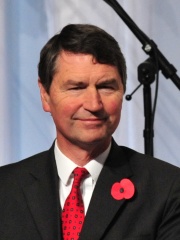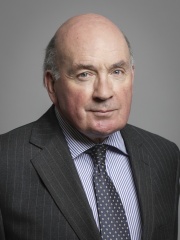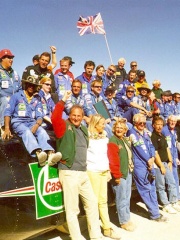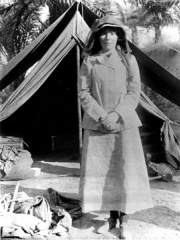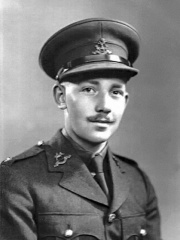
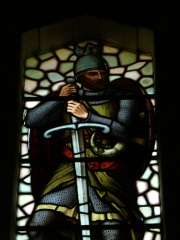

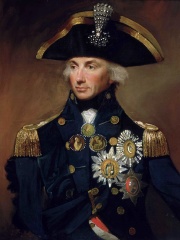
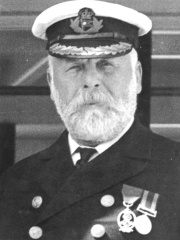

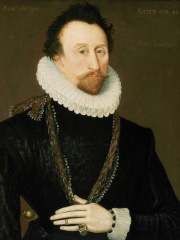

The Most Famous
MILITARY PERSONNELS from United Kingdom
This page contains a list of the greatest British Military Personnels. The pantheon dataset contains 2,058 Military Personnels, 135 of which were born in United Kingdom. This makes United Kingdom the birth place of the 5th most number of Military Personnels behind Russia, and France.
Top 10
The following people are considered by Pantheon to be the top 10 most legendary British Military Personnels of all time. This list of famous British Military Personnels is sorted by HPI (Historical Popularity Index), a metric that aggregates information on a biography's online popularity. Visit the rankings page to view the entire list of British Military Personnels.

1. Bernard Montgomery (1887 - 1976)
With an HPI of 84.19, Bernard Montgomery is the most famous British Military Personnel. His biography has been translated into 71 different languages on wikipedia.
Field Marshal Bernard Law Montgomery, 1st Viscount Montgomery of Alamein, (17 November 1887 – 24 March 1976), nicknamed "Monty", was a senior British Army officer who served in the First World War, the Irish War of Independence and the Second World War. Montgomery first saw action in the First World War as a junior officer of the Royal Warwickshire Regiment. At Méteren, near the Belgian border at Bailleul, he was shot through the right lung by a sniper during the First Battle of Ypres. On returning to the Western Front as a general staff officer, he took part in the Battle of Arras in April–May 1917. He also took part in the Battle of Passchendaele in late 1917 before finishing the war as chief of staff of the 47th (2nd London) Division. In the inter-war years he commanded the 17th (Service) Battalion, Royal Fusiliers and, later, the 1st Battalion, Royal Warwickshire Regiment before becoming commander of the 9th Infantry Brigade and then general officer commanding (GOC), 8th Infantry Division. During the Western Desert campaign of the Second World War, Montgomery commanded the Eighth Army from August 1942. He subsequently commanded the Eighth Army during the Allied invasion of Sicily and the Allied invasion of Italy and was in command of all Allied ground forces during the Battle of Normandy (Operation Overlord), from D-Day on 6 June 1944 until 1 September 1944. He then continued in command of the 21st Army Group for the rest of the North West Europe campaign, including the failed attempt to cross the Rhine during Operation Market Garden. When German armoured forces broke through the US lines in Belgium during the Battle of the Bulge, Montgomery received command of the northern shoulder of the Bulge. Montgomery's 21st Army Group, including the US Ninth Army and the First Allied Airborne Army, crossed the Rhine in Operation Plunder in March 1945. By the end of the war, troops under Montgomery's command had taken part in the encirclement of the Ruhr Pocket, liberated the Netherlands, and captured much of north-west Germany. On 4 May 1945, Montgomery accepted the surrender of the German forces in north-western Europe at Lüneburg Heath, south of Hamburg, after the surrender of Berlin to the USSR on 2 May. After the war he became Commander-in-Chief of the British Army of the Rhine (BAOR) in Germany and then Chief of the Imperial General Staff (1946–1948). From 1948 to 1951, he served as Chairman of the Commanders-in-Chief Committee of the Western Union. He then served as NATO's Deputy Supreme Allied Commander Europe until his retirement in 1958.

2. William Wallace (1270 - 1305)
With an HPI of 80.95, William Wallace is the 2nd most famous British Military Personnel. His biography has been translated into 80 different languages.
Sir William Wallace (Scottish Gaelic: Uilleam Uallas, pronounced [ˈɯʎam ˈuəl̪ˠəs̪]; Norman French: William le Waleys; c. 1270 – 23 August 1305) was a Scottish knight who became one of the main leaders during the First War of Scottish Independence. Along with Andrew Moray, Wallace defeated an English army at the Battle of Stirling Bridge in September 1297. He was appointed Guardian of Scotland and served until his defeat at the Battle of Falkirk in July 1298. In August 1305, Wallace was captured in Robroyston, near Glasgow, and handed over to King Edward I of England, who had him hanged, drawn and quartered for high treason and crimes against English civilians. Since his death, Wallace has obtained a legendary status beyond his homeland. He is the protagonist of Blind Harry's 15th-century epic poem The Wallace and the subject of literary works by Jane Porter and Sir Walter Scott, and of the Academy Award-winning film Braveheart.

3. Robert Baden-Powell, 1st Baron Baden-Powell (1857 - 1941)
With an HPI of 80.61, Robert Baden-Powell, 1st Baron Baden-Powell is the 3rd most famous British Military Personnel. His biography has been translated into 77 different languages.
Lieutenant-General Robert Stephenson Smyth Baden-Powell, 1st Baron Baden-Powell, ( BAY-dən POH-əl; 22 February 1857 – 8 January 1941) was a British Army officer, writer, founder of The Boy Scouts Association and its first Chief Scout, and founder, with his sister Agnes, of The Girl Guides Association. Baden-Powell wrote Scouting for Boys, which with his previous books – such as his 1884 Reconnaissance and Scouting and his 1899 Aids to Scouting for N.-C.Os and Men, which was intended for the military, and The Scout magazine – helped the rapid growth of the Scout Movement. Educated at Charterhouse School, Baden-Powell served in the British Army from 1876 until 1910 in India and Africa. In 1899, during the Second Boer War in South Africa, Baden-Powell defended the town in the Siege of Mafeking. His books, written for military reconnaissance and scout training, were also read by boys and used by teachers and youth organisations. In August 1907, he held an experimental camp, the Brownsea Island Scout camp to test his ideas for training boys in scouting. He wrote Scouting for Boys, published in 1908 by C. Arthur Pearson Limited, for boy readership. In 1910, Baden-Powell retired from the army and formed The Scout Association. In 1909, a rally of Scouts was held at The Crystal Palace. Many girls in Scout uniform attended and, in front of the press, a small group told Baden-Powell that they were the "Girl Scouts". In 1910, Baden-Powell and his sister Agnes started The Girl Guides Association. In 1912, Baden-Powell married Olave St Clair Soames. He gave guidance to The Scout Association and Girl Guides Association until retiring in 1937. Baden-Powell lived his last years in Nyeri, Kenya, where he died and was buried in 1941. His grave is a national monument.

4. Horatio Nelson, 1st Viscount Nelson (1758 - 1805)
With an HPI of 78.38, Horatio Nelson, 1st Viscount Nelson is the 4th most famous British Military Personnel. His biography has been translated into 84 different languages.
Horatio Nelson, 1st Viscount Nelson, 1st Duke of Bronte (29 September 1758 – 21 October 1805) was a British Royal Navy officer whose leadership, grasp of strategy and unconventional tactics brought about a number of decisive British naval victories during the French Revolutionary and Napoleonic Wars. He is widely regarded as one of the greatest admirals in history and, by many, as the greatest. Nelson was born into a moderately prosperous Norfolk family and joined the navy through the influence of his uncle Maurice Suckling, a high-ranking naval officer. Nelson rose rapidly through the ranks and served with leading naval commanders of the period before obtaining his own command at the age of 20 in 1778. He developed a reputation for personal valour and a firm grasp of tactics, but suffered periods of illness and unemployment after the end of the American War of Independence. The outbreak of the French Revolutionary Wars allowed Nelson to return to service, where he was particularly active in the Mediterranean Sea. He fought in several minor engagements off Toulon and was important in the capture of Corsica, where he was wounded and partially lost sight in one eye, and subsequently performed diplomatic duties with the Italian states. In 1797, he distinguished himself while commanding HMS Captain at the Battle of Cape St Vincent. Shortly after this battle, Nelson took part in the Battle of Santa Cruz de Tenerife, where the attack failed and he lost his right arm, forcing him to return to England to recuperate. The following year he won a decisive victory over the French at the Battle of the Nile and remained in the Mediterranean to support the Kingdom of Naples against a French invasion. In 1801, Nelson was dispatched to the Baltic Sea and defeated neutral Denmark at the Battle of Copenhagen. He commanded the blockade of the French and Spanish fleets at Toulon and, after their escape, chased them to the West Indies and back but failed to bring them to battle. After a brief return to England, he took over the Cádiz blockade in 1805. On 21 October 1805, the Franco-Spanish fleet came out of port, and Nelson's fleet engaged them at the Battle of Trafalgar. The battle became Britain's greatest naval victory, but Nelson, aboard HMS Victory, was fatally wounded by a French marksman. His body was brought back to England, where he was accorded a state funeral, and considered a hero. Nelson's death at Trafalgar secured his position as one of Britain's most heroic figures. His signal just prior to the commencement of the battle, "England expects that every man will do his duty", is regularly quoted and paraphrased. Numerous monuments, including Nelson's Column in Trafalgar Square, London, and the Nelson Monument in Edinburgh, have been created in his memory. In 2002, Nelson was named among the 100 Greatest Britons of all time.
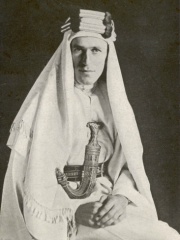
5. T. E. Lawrence (1888 - 1935)
With an HPI of 76.94, T. E. Lawrence is the 5th most famous British Military Personnel. His biography has been translated into 78 different languages.
Thomas Edward Lawrence (16 August 1888 – 19 May 1935) was a British Army officer, archaeologist, diplomat and writer known for his role during the Arab Revolt and Sinai and Palestine campaign against the Ottoman Empire in the First World War. The breadth and variety of his activities and associations, and Lawrence's ability to describe them vividly in writing, earned him international fame as Lawrence of Arabia, a title used for the 1962 film based on his wartime activities. Lawrence was born in Tremadog, Carnarvonshire, Wales, the illegitimate son of Sir Thomas Chapman, an Anglo-Irish landowner, and Sarah Lawrence (née Junner), a governess in the employ of Chapman. In 1896, Lawrence moved to Oxford, attending the City of Oxford High School for Boys, and read history at Jesus College, Oxford, from 1907 to 1910. Between 1910 and 1914, he worked as an archaeologist for the British Museum, chiefly at Carchemish in Ottoman Syria. After the outbreak of war in 1914, Lawrence joined the British Army and was stationed at the Arab Bureau, a military intelligence unit in Egypt. In 1916, he travelled to Mesopotamia and Arabia on intelligence missions and became involved with the Arab revolt against Ottoman rule. Lawrence was ultimately assigned to the British Military Mission in the Hejaz as a liaison to Emir Faisal, a leader of the revolt. He participated in engagements with the Ottoman military culminating in the capture of Damascus in October 1918. After the war's end, he joined the Foreign Office, working with Faisal. In 1922, Lawrence retreated from public life and served as an enlisted man in the Army and Royal Air Force (RAF) until 1935. He published the Seven Pillars of Wisdom in 1926, an autobiographical account of his participation in the Arab Revolt. Lawrence also translated books into English and wrote The Mint, which detailed his service in the RAF. He corresponded extensively with prominent artists, writers, and politicians, and also participated in the development of rescue motorboats for the RAF. Lawrence's public image resulted in part from the sensationalised reporting of the Arab Revolt by American journalist Lowell Thomas, as well as from Seven Pillars of Wisdom. In 1935, Lawrence died at the age of 46 after being injured in a motorcycle crash in Dorset.

6. Edward Smith (1850 - 1912)
With an HPI of 75.53, Edward Smith is the 6th most famous British Military Personnel. His biography has been translated into 51 different languages.
Captain Edward John Smith (27 January 1850 – 15 April 1912) was an English sea captain and naval officer. In 1880, he joined the White Star Line as an officer, beginning a long career in the British Merchant Navy. Smith went on to serve as the master of numerous White Star Line vessels and was chosen to captain many of them on their maiden voyages. During the Second Boer War, he served in the Royal Naval Reserve, transporting British Imperial troops to the Cape Colony. In 1912, Smith served as captain of the ocean liner Titanic, and perished along with 1,495 others when she sank on her maiden voyage.

7. Claude Auchinleck (1884 - 1981)
With an HPI of 74.81, Claude Auchinleck is the 7th most famous British Military Personnel. His biography has been translated into 37 different languages.
Field Marshal Sir Claude John Eyre Auchinleck, ( OKH-in-LEK; 21 June 1884 – 23 March 1981) was a British Indian Army commander who saw active service during the world wars. A career soldier who spent much of his military career in India, he rose to become commander-in-chief of the Indian Army by early 1941 during the Second World War. In July 1941 he was appointed commander-in-chief of the Middle East Theatre, but after initial successes the war in North Africa turned against the British-led forces under his command and he was relieved of the post in August 1942 during the North African campaign. In June 1943, he was once again appointed Commander-in-Chief, India, where his support through the organisation of supply, maintenance and training for General William Slim's Fourteenth Army played an important role in its success. He served as commander-in-chief, India, until the Partition in 1947, when he assumed the role of supreme commander of all British forces in India and Pakistan until late 1948.

8. John Hawkins (1532 - 1595)
With an HPI of 73.58, John Hawkins is the 8th most famous British Military Personnel. His biography has been translated into 32 different languages.
Admiral Sir John Hawkins (also spelled Hawkyns) (1532 – 1595) was an English naval commander, naval administrator, privateer and slave trader. Hawkins pioneered, and was an early promoter of, English involvement in the Atlantic slave trade. He is considered to be the first English merchant to profit from the Triangle Trade, selling enslaved people from Africa to the Spanish colonies in the West Indies in the late 16th century. In 1588, Hawkins served as a Vice-Admiral and fought in the victory over the Spanish Armada, for which he was knighted for gallantry. As Treasurer of the Navy, Hawkins became the chief architect of the Elizabethan Navy. He redesigned the navy so the ships were faster, more manoeuvrable and had more firepower. Hawkins' son, Richard Hawkins, was captured by the Spanish. In response, along with his cousin Sir Francis Drake, he raised a fleet of ships to attack the Spanish in the West Indies. However, he died at sea during the expedition.

9. Alexander Selkirk (1676 - 1721)
With an HPI of 73.27, Alexander Selkirk is the 9th most famous British Military Personnel. His biography has been translated into 42 different languages.
Alexander Selkirk (1676 – 13 December 1721) was a Scottish privateer and Royal Navy officer who spent four years and four months as a castaway (1704–1709) after being marooned by his captain, initially at his request, on an uninhabited island in the South Pacific Ocean. Selkirk was an unruly youth and joined buccaneering voyages to the South Pacific during the War of the Spanish Succession. One such expedition was on Cinque Ports, captained by Thomas Stradling, under the overall command of William Dampier. Stradling's ship stopped to resupply at the uninhabited Juan Fernández Islands, west of South America, and Selkirk judged correctly that the craft was unseaworthy and asked to be left there. Selkirk's suspicions were soon justified, as Cinque Ports foundered near Malpelo Island 400 km (250 mi) from the coast of what is now Colombia. By the time he was eventually rescued by the privateer Woodes Rogers, who was accompanied by Dampier, Selkirk had become adept at hunting and making use of the resources that he found on the island. His story of survival was widely publicized after his return and became one of the reputed sources of inspiration for the fictional character Robinson Crusoe of the English writer Daniel Defoe.

10. William Stuart-Houston (1911 - 1987)
With an HPI of 73.12, William Stuart-Houston is the 10th most famous British Military Personnel. Her biography has been translated into 25 different languages.
William Patrick Stuart-Houston (born William Patrick Hitler; 12 March 1911 – 14 July 1987) was a British-American entrepreneur and the half-nephew of Adolf Hitler. Born and raised in the Toxteth area of Liverpool to Adolf's half-brother Alois Hitler Jr. and his Irish wife Bridget Dowling, he later relocated to Germany in the 1930s to find work with the help of his half-uncle until he got into some issues with him and later returned to London. He later immigrated to the United States, where he received American citizenship (in addition to his British citizenship) and ended up serving in the United States Navy against his half-uncle and Nazi Germany during World War II, changing his surname after the war.
People
Pantheon has 135 people classified as British military personnels born between 1270 and 1974. Of these 135, 7 (5.19%) of them are still alive today. The most famous living British military personnels include Timothy Laurence, Andrew Parker Bowles, and Richard Dannatt. The most famous deceased British military personnels include Bernard Montgomery, William Wallace, and Robert Baden-Powell, 1st Baron Baden-Powell. As of April 2024, 1 new British military personnels have been added to Pantheon including Chris Ryan.
Living British Military Personnels
Go to all RankingsTimothy Laurence
1955 - Present
HPI: 69.52
Andrew Parker Bowles
1939 - Present
HPI: 62.11
Richard Dannatt
1950 - Present
HPI: 62.02
Andy Green
1962 - Present
HPI: 55.55
Andy McNab
1959 - Present
HPI: 50.40
Craig Harrison
1974 - Present
HPI: 48.49
Chris Ryan
1961 - Present
HPI: 43.56
Deceased British Military Personnels
Go to all RankingsBernard Montgomery
1887 - 1976
HPI: 84.19
William Wallace
1270 - 1305
HPI: 80.95
Robert Baden-Powell, 1st Baron Baden-Powell
1857 - 1941
HPI: 80.61
Horatio Nelson, 1st Viscount Nelson
1758 - 1805
HPI: 78.38
T. E. Lawrence
1888 - 1935
HPI: 76.94
Edward Smith
1850 - 1912
HPI: 75.53
Claude Auchinleck
1884 - 1981
HPI: 74.81
John Hawkins
1532 - 1595
HPI: 73.58
Alexander Selkirk
1676 - 1721
HPI: 73.27
William Stuart-Houston
1911 - 1987
HPI: 73.12
Gertrude Bell
1868 - 1926
HPI: 72.32
Captain Tom
1920 - 2021
HPI: 72.30
Newly Added British Military Personnels (2025)
Go to all RankingsOverlapping Lives
Which Military Personnels were alive at the same time? This visualization shows the lifespans of the 25 most globally memorable Military Personnels since 1700.

